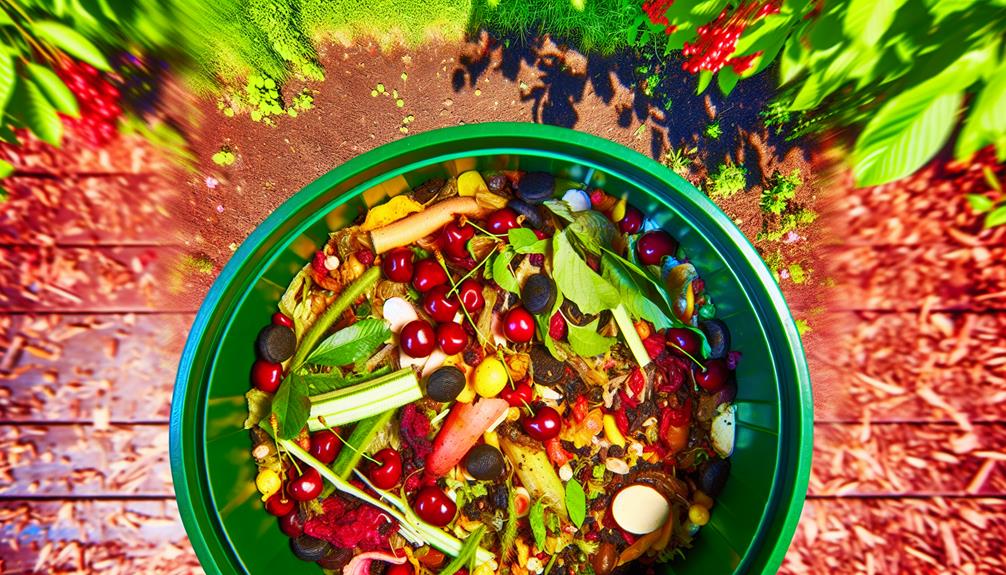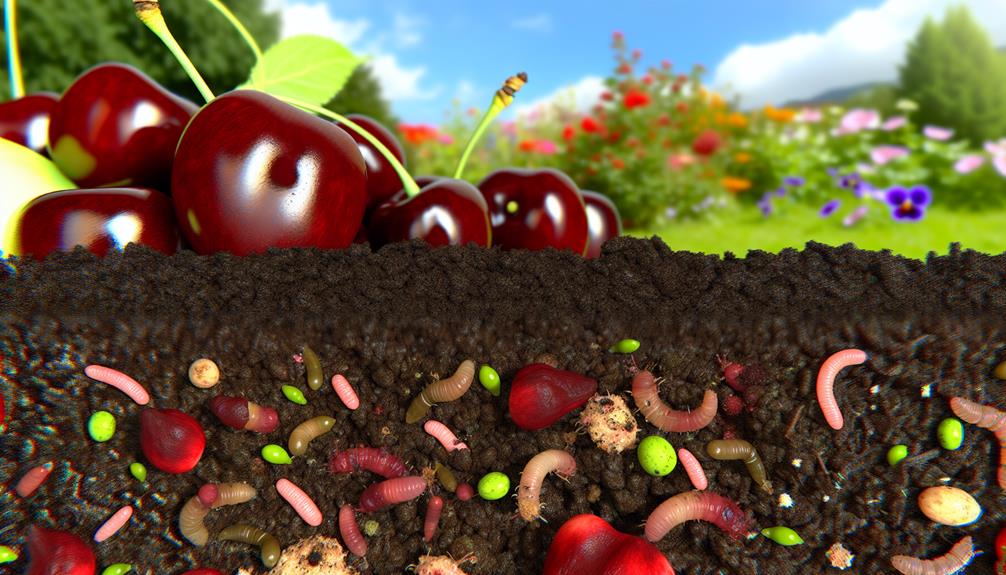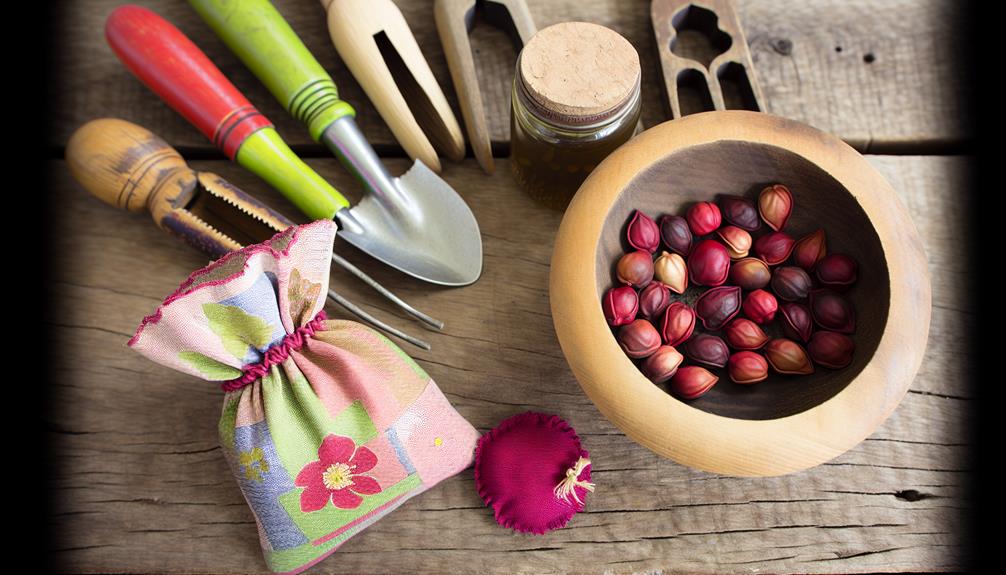

Yes, you can compost cherry pits. They contain valuable nutrients like nitrogen, phosphorus, and potassium. To expedite decomposition, crush or chip the pits first. This increases the surface area for microbial activity. Add them in small quantities to balance your compost pile since they decompose slowly due to their hard exterior.
Guarantee a mix of green and brown materials, and keep your pile moist and aerated. While the cyanide in cherry pits neutralizes during composting, it’s wise to keep pets and children away from the compost. For more methods and tips to optimize your composting process, continue exploring.
Cherry pits, often overlooked as mere waste, actually hold valuable nutrients that can benefit your compost pile. When you explore cherry anatomy, you’ll find that the pit, also known as the stone, is the hard seed found at the center of the fruit. This part of the cherry is packed with nutrients like nitrogen, phosphorus, and potassium, which are important for a healthy compost pile.
However, it’s important to be aware of pit toxicity. Cherry pits contain amygdalin, a compound that can release cyanide when metabolized. While this sounds alarming, don’t worry—composting cherry pits in small quantities is generally safe.
The composting process breaks down amygdalin, neutralizing its toxic effects over time. Just make sure to balance your compost pile with plenty of other organic materials to aid in this breakdown.
Also Read: Can You Compost Blood?
To start composting, you’ll need to understand how organic materials break down and the various methods you can use.
Composting involves creating the right conditions for microorganisms to turn waste into nutrient-rich soil.
From basic backyard piles to more sophisticated bin systems, each method has its own set of steps and benefits.
Understanding the basics of composting is essential for effectively breaking down organic materials like cherry pits. Knowing the fruit anatomy and seed composition can make a big difference. Cherry pits are the hard seeds found inside cherries, encased in a tough outer shell. This shell is designed to protect the seed, making it resistant to quick decomposition.
To help break down these stubborn pits, you need to create the right conditions in your compost pile. Start by maintaining a good balance of green and brown materials. Green materials, like fruit scraps and grass clippings, provide nitrogen, while brown materials, such as dried leaves and cardboard, supply carbon. This balance is important for microbial activity, which drives the decomposition process.
Chop the cherry pits or crush them to speed up their breakdown. Smaller pieces decompose faster and more efficiently. Keep your compost pile moist but not waterlogged, and turn it regularly to aerate it. This ensures that oxygen reaches the microbes responsible for breaking down the organic matter.
Various composting methods exist to help you efficiently break down organic materials, including cherry pits. Understanding these methods can enhance your composting success, whether you’re dealing with different cherry varieties or the specific pit anatomy.
First, consider traditional composting, where you combine green and brown materials in a pile. Cherry pits, being hard, need a longer time to decompose. Crushing them beforehand can speed up this process. Make sure your compost pile is well-aerated and maintains the right moisture levels to encourage microbial activity.
Next, think about vermicomposting, which uses worms to break down organic matter. While worms aren’t keen on cherry pits due to their hard shells, you can still add them in small quantities. Over time, the pits will break down, especially if you crush them to start.
Lastly, you might explore bokashi composting, an anaerobic method using a special bran to ferment organic waste. Cherry pits can be included here too, though they’ll need to be buried in soil after fermentation for complete decomposition.
Understanding the decomposition timeline of cherry pits is essential for effective composting.

You’ll need to take into account factors like temperature, moisture, and the pit’s hardness.
The decomposition timeline for cherry pits depends on several factors, including environmental conditions, pit size, and microbial activity. Different cherry varieties have pits with varying seed structures, which can influence how quickly they break down. For instance, some pits might have a harder outer shell, making them more resistant to decomposition.
You’ll notice that cherry pits decompose faster in warmer, moist environments with plenty of microbial activity. High temperatures and adequate moisture levels speed up the breakdown process. Conversely, if the compost pile is too dry or cold, the decomposition will slow considerably.
Pit size also plays a critical role. Larger pits take longer to break down than smaller ones. You can speed up the process by crushing or breaking the pits before adding them to your compost pile. This increases the surface area exposed to microbes, enhancing the decomposition rate.
To foster a sense of community in your composting efforts, share tips and experiences with neighbors or a local gardening group. This way, you can learn from others’ successes and challenges, making the composting journey more enjoyable and efficient for everyone involved.
Considering how pit size and environmental conditions affect decomposition, it’s important to assess the broader environmental impact of composting cherry pits. The decomposition timeline of cherry pits can be quite long, often taking several years due to their hard exterior. While this might seem discouraging, it’s worth noting that cherry pits don’t produce harmful byproducts during this period.
You might wonder if cherry pits offer any nutritional value to your compost. While they don’t break down quickly enough to provide immediate nutrients, over time they can contribute to the overall structure of your compost pile, enhancing aeration and moisture retention. This slow release of nutrients can be beneficial for long-term soil health.
Moreover, considering their potential culinary uses, cherry pits can be repurposed before composting. For instance, they can be used to make cherry pit vinegar or infused oils, extending their life cycle before they enter your compost pile.
To speed up the decomposition of cherry pits, you can try several effective methods that break down their tough exterior more quickly. First, understand that cherry varieties have differences in pit anatomy, with some being more challenging to decompose than others.
Crushing the pits is a straightforward method to accelerate decomposition. You can use a hammer or a mortar and pestle to break them into smaller pieces. Smaller fragments decompose faster because they’ve more surface area exposed to microbes.
Soaking the pits in water before composting also helps. A 24-hour soak softens the hard outer shell, making it easier for microorganisms to penetrate and break down the material.
Another method is to combine the cherry pits with high-nitrogen materials like grass clippings or kitchen scraps. This creates a hot compost pile, which speeds up the decomposition process.
You can also try using commercial compost accelerators. These products contain enzymes and bacteria designed to boost microbial activity, making it easier to break down tough materials like cherry pits.
Also Read: Can You Compost Bag?
Cherry pits, though small, pack a remarkable punch when it comes to enriching your compost with essential nutrients. These pits contribute to soil enrichment by breaking down slowly and releasing valuable minerals. Their nutrient density can greatly boost your compost mix, providing a richer environment for your plants.
Here’s how cherry pits elevate the nutrient profile of your compost:
| Nutrient | Benefit | Contribution to Compost |
|---|---|---|
| Potassium | Enhances root growth | Improves plant resilience |
| Phosphorus | Aids in energy transfer | Promotes blooming and fruiting |
| Calcium | Strengthens cell walls | Prevents nutrient deficiencies |
Adding cherry pits to your compost helps create a more balanced nutrient mix. This, in turn, supports a diverse range of plant needs, making your garden more robust and thriving. Just remember, cherry pits take time to decompose, so patience is key.
Breaking down cherry pits efficiently requires using effective grinding methods. You’ll need to choose the right tools to tackle those tough little seeds, no matter the cherry varieties you’re dealing with.
Understanding pit anatomy is essential; cherry pits are hard and have a dense, woody shell that protects the seed inside. This makes them difficult to break down by traditional composting methods alone.
To start, consider using a mortar and pestle for small batches. This manual method lets you grind the pits into smaller pieces, increasing their surface area, which helps them decompose faster.
For larger quantities, a heavy-duty food processor or grinder is more efficient. Make sure your equipment is robust enough to handle the hardness of cherry pits. Some people also use hammer mills, particularly if they’re composting large volumes regularly.
Another practical tip is to freeze the pits first. Freezing them can make them more brittle, making grinding easier. Remember, each cherry variety might’ve slightly different pit characteristics, so adjust your method as necessary.
When composting cherry pits, you must be mindful of certain safety concerns to guarantee a hazard-free process. Cherry pits contain amygdalin, which can release cyanide when metabolized. While the toxicity risks are low in small amounts, it’s still crucial to handle them carefully.
First, consider the ingestion hazards. Pets and children might mistake cherry pits for something edible. Make sure they are securely buried in your compost pile to minimize this risk. Also, grinding the pits can reduce these dangers, as the smaller pieces are less likely to be ingested.
To help you understand these safety concerns better, here’s a quick comparison:
| Safety Concern | Recommended Action |
|---|---|
| Toxicity Risks | Grind pits before composting |
| Ingestion Hazards | Securely bury in compost |
| Pet Safety | Keep pets away from compost |
| Child Safety | Educate and supervise |
It’s important to recognize that while cherry pits can be composted, they require special attention. By following these guidelines, you’ll foster a safe and thriving composting community. Your efforts will not only benefit your garden but also ensure that your composting habits remain safe and responsible for everyone involved.
Also Read: Can You Compost Animal Hair?
You’d be surprised at the numerous creative ways to repurpose cherry pits beyond composting. For those passionate about culinary uses, cherry pits can be transformed into a variety of flavorful infusions. Clean the pits thoroughly and use them to create cherry pit syrup or liqueur. You can also use them to infuse oils and vinegars, adding a unique, subtle cherry taste to your dishes.

If you’re inclined towards craft projects, cherry pits offer endless possibilities. One popular option is to use them as filler for homemade heating pads. Simply sew a small pouch, fill it with clean, dried cherry pits, and you have a reusable, microwavable heating pad that retains heat exceptionally well.
Additionally, you can incorporate cherry pits into your potpourri mixes. Their smooth texture and subtle fragrance complement other natural elements, creating a pleasant aroma for your home.
Another fun idea for craft enthusiasts is making cherry pit necklaces or bracelets. Drill small holes in the pits, string them together, and you’ve got a unique, eco-friendly piece of jewelry. These projects not only repurpose waste but also foster a sense of community and creativity among like-minded individuals.
To get the most out of composting cherry pits, experts recommend several key techniques that guarantee efficiency and effectiveness. Understanding the pit anatomy is important because cherry pits have a hard outer shell that can take a long time to break down.
Here’s how you can speed up the process and make your compost pile thrive:
You can compost cherry pits, but to prevent pests, make sure to bury them deep in the pile. This helps with pest prevention and reduces compost odor, keeping your composting community happy and pest-free.
When choosing a composting bin, look for one with durable bin material and good aeration techniques. These features guarantee your cherry pits decompose efficiently. You’ll feel part of a community dedicated to sustainable practices.
You’re wondering how cherry pits affect the pH balance of compost. They don’t greatly alter soil acidity but can influence microbial activity by breaking down slowly, enriching your compost community over time. Happy composting!
You can compost cherry pits in a worm bin, but it’s slow. Worm digestion struggles with hard pits, so cherry decomposition takes longer. Including pits creates a sense of community among eco-conscious gardeners working towards zero waste.
Yes, you should pre-treat cherry pits before adding them to compost. Use pit cracking or heat treatment to speed up decomposition. By doing this, you’ll guarantee your composting efforts are efficient and effective, benefiting the community.
To conclude, you can compost cherry pits, but be aware they decompose slowly. To speed up the process, consider grinding them first.
While they don’t add significant nutrients, they can help with aeration. Always handle pits with care due to their cyanide content.
Alternatively, use them in crafts or as mulch. By understanding these aspects, you’ll make better decisions for your compost and garden.
Follow these tips for effective composting and safety.
